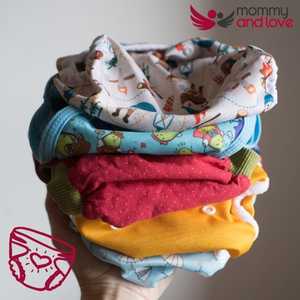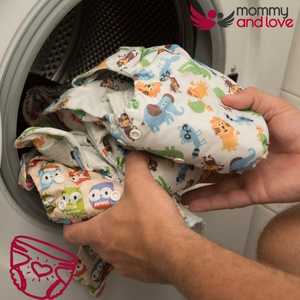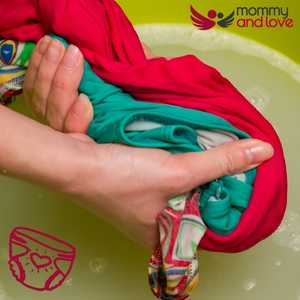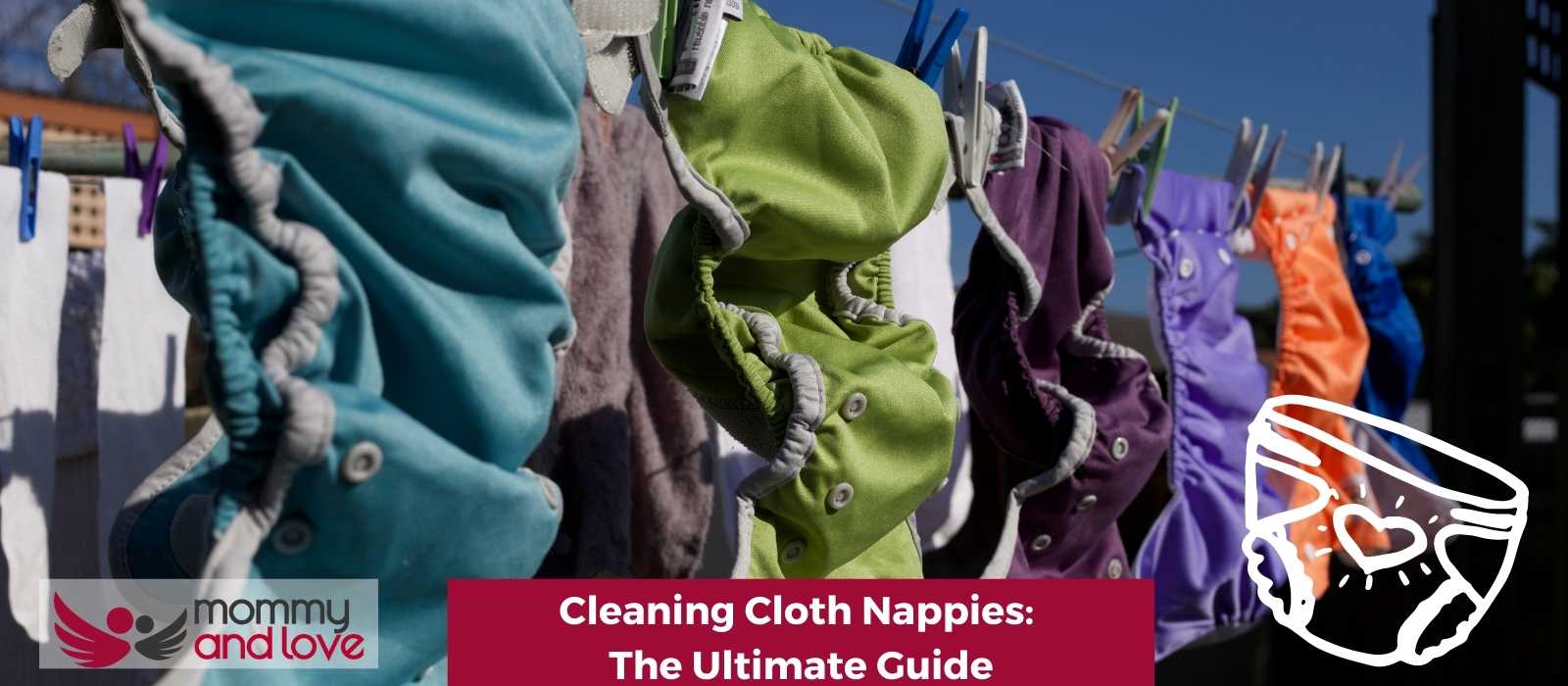Looking for a comprehensive guide on how to clean cloth nappies? You’ve come to the right place! In this blog post, we will discuss everything you need to know in order to keep your little one’s bum clean and healthy.
We’ll cover everything from pre-washing to stain removal, so you can feel confident about using cloth nappies without having to worry about ruining them. Let’s get started!
It all comes out in the wash…..

Fortunately, today’s washing machines have taken all the hard work out of laundering reusable nappies. With a little care – and paying attention to modern cloth nappy care instructions – you can quite easily keep your real nappies in tip-top condition.
Here are some nappy washing tips that we’ve collected for you.
Storing Soiled Nappies
The first thing you need to decide is whether to use a nappy bucket for dirty nappies or use a hanging wet bag to store the soiled nappies. We’ve got several detailed guides on this.
- Reusable Nappy Storage – Your Options Considered
- Dirty Cloth Diaper Storage: How To Keep Your Home Odor-Free
- Dry Pailing Nappies (Complete Guide To Storing Dirty Nappies)
- Nappy Wet Bags
- Nappy Liners – Complete Guide
- Do I Need A Mesh Washing Bag For Cloth Nappies?
The next decision is whether to use disposable liners or fleece liners. We’ve a complete guide to nappy liners here. Both of these are there to catch any solids and flush them down the toilet bowl before you do your nappy wash.
When it comes to pocket nappies, the jury is out on whether to remove the inners before washing. Some people do, some don’t. If you are taking the inners out, do this to all the nappies before you put them in the nappy bin.
Pre Washing or Pre Rinsing Diapers

All cloth nappies – regardless of style or design – need to be prewashed. Not only does prewashing remove any softeners, which have been used on the nappies by manufacturers, it also ensures absorbency.
We would recommend a cold prewash with no powder, followed by a long cotton wash at 40°-60° using only half of your usual dose of biological washing powder, or else a powder that’s specifically manufactured for cloth nappies. You can then follow this with a final rinse.
Fabrics like cotton will take two or three prewashes, while bamboo and hemp fabrics can take up to ten washes to reach their full absorbency. Never use fabric softener or bleach.
The first step in cleaning cloth nappies is to pre-wash them on a cold rinse cycle. This can be done by simply throwing them in the washing machine with no detergent on a pre wash cycle.
Modern washing machines should have this option, if not do a quick eco wash with no powder in place of the pre wash cycle.
It’s important to rinse nappies before washing as pre-washing will help remove any build-up of urine or feces that may be on the nappy, it effectively will sluice the dirty nappies about before you go ahead and wash nappies.
If you’re using a front-loading washing machine, you can pre-wash your nappies by adding them to the machine and running a quick cycle.
If you have a top-loading machine, you’ll need to fill up the tub with water and then add your nappies.
Either way, once the cycle is done, you can move on to washing your nappies as usual on your normal wash cycle.
Washing Cloth Nappies

Now that you’ve pre-washed your reusable nappies, it’s time to wash them as normal with a full detergent dose.
You can use any type of detergent, but it’s important to make sure that it doesn’t contain any harsh chemicals or fragrances which may affect the nappy fabrics (particularly if they are made from natural fibres). Also, these can cause irritation to your baby’s skin.
To wash your nappies, simply add them to your washing machine along with the appropriate amount of detergent. Run a regular cycle and then dry them as usual.
It’s important to note that you should never use bleach on cloth nappies. Bleach is a harsh chemical that can damage the fabric and cause irritation to your baby’s skin.
How to Clean
Firstly you need to consider if you need to do a separate nappy wash. If you have a full washload of just nappies then this is not an issue. We’ve done a guide to washing cloth nappies with other clothes.
Your wash cycle will depend on what nappies you have whether they are bamboo nappies, microfibre nappies or even if you are washing nappy covers. It’s important to know the washing temperature for each of the types of nappies you have.
Prefolds can take a boil wash whilst this would destroy all in one nappy or woollen nappies. It’s important to follow the washing instructions from the manufacturers as the last thing you want to do is potentially ruin your nappies on a hot wash cycle.
Also you need to consider how many nappies you can fit in the washing machine. Don’t stuff too many in as they just won’t wash properly. 12-15 is maximum for a normal 7kg washing machine load.
- Can I Wash Reusable Nappies With Other Clothes?
- How To Get Baby Poop Stains Out Of Clothes & Cloth Nappies?
Once you have washed your nappies and have your wash routine sorted, you need to consider how to dry nappies. Whilst tumble drying is ok, it really is better to dry on the line. Line drying can help remove any stains in the nappies. We’ve done a full guide to how to dry your nappies here:
It goes without saying that the best, cheapest and most environmentally-friendly way to dry your nappies is on the line outside. Having said that, we have to be practical and take into account our unreliable climate, so we’re left with either drying on a rack indoors, drying on the radiator or in the tumble drier.
While your wraps, liners (washable) and wipes will all dry relatively quickly anywhere, the drying times of nappies can vary greatly, so this is something that you’ll need to consider when you’re making your choice of nappies – particularly if you are limited in the amount of room that you have for drying.
As a general rule:
– Man-made or synthetic fabrics, such as fleece or microfibre will dry most quickly and be almost dry to the touch after a spin cycle.
– Cotton also dries quickly, with terries and prefolds the fastest drying.
– Bamboo and hemp nappies and all-in-one nappies will take the longest to dry.
– Pocket nappies are another ‘quick dry’ option – mainly because the absorbent layer can be removed and dried separately.
If your preferred option is one of the types that takes the longest to dry, why not alternate those nappies with one of the faster-drying versions to save you time?
If you have to dry indoors, then invest in an indoor ceiling airer or indoor drying rack, which you can place close to a radiator for maximum impact. You can dry nappies, liners, boosters etc on a radiator, but remember that the prolonged and concentrated contact with the heat could potentially harm the elastic or fabric of your nappies, so be careful!
If you find that you have no other option than to tumble dry, then make sure that you always check the label on your nappies before you do, so that you know which cloth nappies tumble dry! Some nappy manufacturers will specify that you only tumble dry at a low setting, while others will state that tumble drying is a complete no-no!
If you go against the manufacturers’ specifications, then you may find that your warranty is invalidated. Some manufacturers provide extended cloth nappy washing instructions on the packaging, so remember to check these too before you throw them out.
Experiment with drying times for different nappies and always use tumble dryer balls as it has been proven that that items dry more quickly by using them.
Washing Powder Questions
When it comes to the best cloth nappy detergent, you usually don’t need to use a specific cloth nappy safe washing powder. We would suggest that, unless you have to use non-bio for your normal wash, you should use a biological powder for nappies.
That’s because biological powder uses enzymes to wash, whereas non-bio replaces these enzymes with other ingredients. These ingredients, we believe, not only don’t wash out easily and are less effective, but leave a residue, which will not only prevent nappies from absorbing fully, but which could lead to leaks.
From using special detergents to what size dose of detergent we’ve covered all you need to know about washing detergent and washing nappies. Some people insist on using non bio washing powder however, bio detergent is often needed to clean thoroughly.
What you put in the washing machine drawer is very important. Whilst most nappies can be washed in bio detergent, bamboo fibre nappies can be destroyed by the bio powder.
Never ever use fabric conditioner or fabric softener when you wash cloth nappies. It coats them and stops them absorbing! We also advise against liquid detergent in the main wash cycle as we find it also leaves a residue on nappies.
- Cloth Nappy Washing Powder
- Bio Or Non-Bio For Baby: Which Is Safer For Babies & Cloth Nappies?
- Cloth Nappy Detergent Buildup: What, Why, How
To wash your nappies, simply add them to your washing machine along with the appropriate amount of detergent for the main wash Run a regular cycle and then dry them as usual.
Problems
Some of the problems with washing nappies can be from too much detergent or from using nappy creams which have clogged the nappies and stopped them from absorbing (or even using fabric softener).
If this has happened, you need to firstly determine if you have cloth nappy detergent build up and then do a strip wash on your nappies. Full guides here:
Diaper Rash
Nappy rash will affect most babies whether you use cloth nappies or disposable diapers for baby’s nappies. We have a very detailed guide to diaper rash and the best treatments available.
- How to wash Yeast Infected Diapers
- Cloth Diaper Safe Nappy Creams
Stain Removal
Even with regular washing, stains can still happen. If you notice a stain on your nappy, don’t panic! There are a few things you can do to remove it without the need for harsh stain removers.
The first thing you can try is using a little bit of Dawn dish soap on the stain. Simply wet the stained area and then rub in a small amount of Dawn. Let it sit for a few minutes and then wash as usual.
If that doesn’t work, you can try using white vinegar. Again, wet the stained area and then rub in some white vinegar. Let it sit for a few minutes and then wash as usual.
If those two methods don’t work, you can try using oxygen bleach. Oxygen bleach is a safe and effective way to remove stains from cloth nappies. Simply follow the instructions on the package and you should be able to get the stain out.

Washing Used Nappies
Once your baby has pooed in its nappy, simply pop the poo into the loo and put your dirty nappy into a nappy bucket, nappy pail or nappy wet bag in the kitchen. You don’t have to wash nappies every day – simply wait until your bucket or bag is full and then pop bucket liner and nappies or the contents of the bag into the washing machine.
Once you’ve used your nappies, you can wash them at 60°. Washing them at a higher temperature may damage your nappies, so 60° is quite sufficient. Many parents now like to wash at lower temperatures, such as 30°-40° , but if you’re going to do this you will need to use a nappy sanitiser – particularly if your baby is under three months of age, is ill, or if the nappies are particularly soiled.
Cleaning nappy wraps is an absolute breeze! The great thing about the wraps is that you can put them into the washing machine in the same wash as your nappies and remember – you don’t always need to wash your wrap every time you change your baby’s nappy though.
A general rule of thumb is to pop the wrap into the washing machine every four to five changes. Of course, if poo gets onto the wrap then you’ll need to either wipe it clean or wash it, but you don’t have to wash the wraps as often as the nappies.
(That is, of course, if you’re working with flat or fitted nappies. If you’re using pocket or all-in-one nappies, then you’ll need to change the whole nappy each time.)
It’s not essential that you soak your nappies before you wash them, but there’s no doubt that soaking can be beneficial to cloth nappies simply because the water dilutes the urine in the fabric, so prolonging the life of the nappy.
The Bottom Line on How to Wash Cloth Nappies
We hope you found this guide helpful! Cleaning cloth nappies doesn’t have to be a daunting task. If you use a disposable liner or a washable liner, the nappy liners will get as much poo down the toilet as possible which will help prevent smelly nappies.
When it comes to new nappies, make sure that you wash them a few times before you use them, you can throw them in with the baby clothes there is no need for them to be washed separately if you are just pre washing.
You need to ensure you have enough nappies to last you 2 days and washing every 2nd day is a great routine to get into. I would also recommend having spare wet bags for when out and about.
Always store your nappies in a dry pail with a lid to prevent them from getting stinky. And finally, make sure you have a good wash routine that you stick to. If you do all of those things, you should be able to keep your nappies clean and fresh with no problems!
You can wash with biological detergents or a non bio detergent, unless its bamboo then stick to the non bio. Do a pre wash, then your normal wash and an extra rinse.
When it comes to drying nappies, whist you can tumble dry, its better if you can avoid the tumble drier and get them on the line!
Good luck on your cloth nappy journey!

This article was written by: Gian MIller – Full-Time Writer, Baby Whisperer & Dad of 3.
Gian spends a lot of his time writing. A self-proclaimed baby whisperer, Gian has been through it all with his own children and is passionate about sharing his hard-won wisdom with other parents. When he’s not writing or changing diapers, you can find him playing the guitar or watching baseball (or preferably both at the same time).




